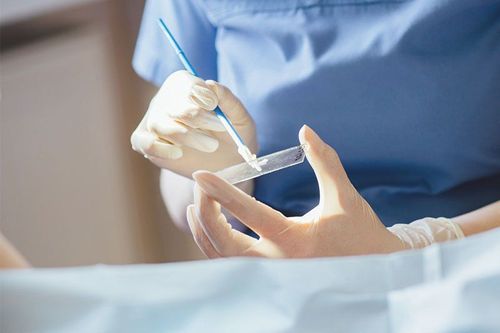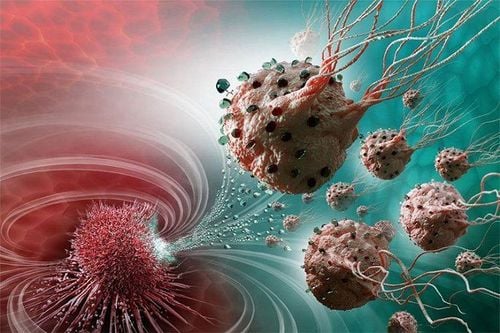This is an automatically translated article.
Cervical biopsy is an extremely necessary procedure to help women observe the vulva, vagina and cervix to detect early diseases in the uterus such as cervical cancer, diseases in the vagina and vulva. . From there, the doctor can recommend the most suitable treatment.1. What is a cervical biopsy?
The cervix is the narrow part of the lower part of the uterus, which is the gateway to the vagina.
Cervical biopsy is a technical process of removing a sample of cervical tissue to check for abnormal conditions, precancerous conditions, or cancer.
Cervical biopsies can be performed using a variety of techniques. In addition to taking tissue samples for examination, during the biopsy process, it is also possible to completely remove abnormal tissue mass, or cells that are at risk of cancer.
2. Uterine Biopsy Tests
Cervical biopsy techniques include:
Punch biopsy: This technique uses a circular blade, like a paper puncher, to take a sample of cervical tissue. During a test, one or more cervical tissue samples from different locations are taken for examination. Cervical cone biopsy: This technique uses a laser or scalpel to remove a large cone-shaped sample of cervical tissue. Endocervical curettage (ECC): This technique uses an instrument called a curette to scrape the lining of the cervical canal. The cervical canal is the area that cannot be seen from the outside of the cervix.
3. Why is a cervical biopsy necessary?
Cervical biopsy should be performed when clinical examination of the pelvic region reveals an abnormality. Cervical biopsies are also done when abnormal cells are detected through the Pap smear. A cervical biopsy may be done to look for cancerous or precancerous cells in the cervix.

Sinh thiết cổ tử cung có thể được tiến hành để tìm các tế bào ung thư hoặc tiền ung thư ở cổ tử cung.
Cervical biopsies are also used for diagnosis and treatment in the following situations:
Abnormal noncancerous masses in the cervix (polyps). Genital warts. Genital warts are synonymous with HPV infection, and HPV is a risk factor for developing cervical cancer. Exposure to diethylstilbestrol (DES), if the patient's mother used DES during pregnancy. DES increases the risk of cancer in the reproductive organs. Your doctor may also recommend a cervical biopsy for other reasons.
4. Possible risks of cervical biopsy
Possible complications when performing a cervical biopsy include:
Infection Bleeding In addition, biopsy of the cervical cone can increase the risk of infertility and miscarriage, because the biopsy The cone of the cervix can change the cervix and leave scar tissue.
Tell your doctor if:
You are sensitive or allergic to drugs, iodine, or latex. Are pregnant or suspect that you are pregnant. Some cervical biopsies can still be performed during pregnancy, but not all techniques are available. Other risks of cervical biopsy may occur depending on the specific situation of each patient. Talk to your doctor carefully before performing the technique.
Certain factors can make cervical biopsy results less accurate, these are:
Menstruation Acute pelvic inflammatory disease Acute cervicitis
5. Preparation before conducting a cervical biopsy
Patients can consult their doctor about all their questions. The patient needs to sign a consent form to have the cervical biopsy done. With a simple biopsy, the patient usually does not need to fast or prepare anything special. If anesthesia is required before the biopsy, the preparation process will be more complicated. If you are pregnant or think you may be pregnant, tell your doctor right away. Inform your doctor if you are sensitive or allergic to drugs, latex, adhesive tape or drugs used for the anesthetic process (local or systemic). Inform your doctor about any medications and supplements you are taking. Inform your doctor if you have a history of blood clotting disorders or are taking medications that have anticoagulant effects. Do not use tampons, creams or vaginal suppositories 24 hours before performing a cervical biopsy. Do not have sex 24 hours before a cervical biopsy. A tampon should be prepared for use after a cervical biopsy. Follow your doctor's other instructions (if applicable).
6. Care After Cervical Biopsy
The patient's care and recovery will depend on the technique of cervical biopsy performed. Usually with a simple biopsy, the patient just needs to rest for a while and then go home.
The patient may want to use tampons, as there may be bleeding after the biopsy. Mild pain, oozing, and dark or black discharge for a few days after the biopsy is normal (the dark discharge is from medication used to stop bleeding during the biopsy).
Patient can relieve pain by taking medicine prescribed by doctor. Do not douche, use tampons, or have sex for 1 week after the biopsy (or for as long as your doctor recommends).

Uống thuốc theo chỉ định của bác sĩ
Inform your doctor immediately if any of the following signs appear:
Bleeding Vaginal discharge with an unpleasant odor Fever and/or chills Severe lower abdominal pain For each individual patient, the doctor will have their own indications and care instructions. Follow your doctor's orders, and complete and timely follow-up visits.
Ideally, cervical biopsy should be conducted after the end of the menstrual cycle about 1 week and selected large and reputable medical facilities not only in the general hospital system but also outstanding, leading in the field of cancer diagnosis and treatment.
For detailed advice on uterine biopsy techniques at Vinmec, you can go directly to Vinmec medical system nationwide or contact to book an online examination HERE.
References: hopkinsmedicine.org, webmd.com and cancer.ca
MORE:
When do you need cervical cancer screening? How long does cervical cancer last? Cervical cancer can be cured in the early stages if detected early













